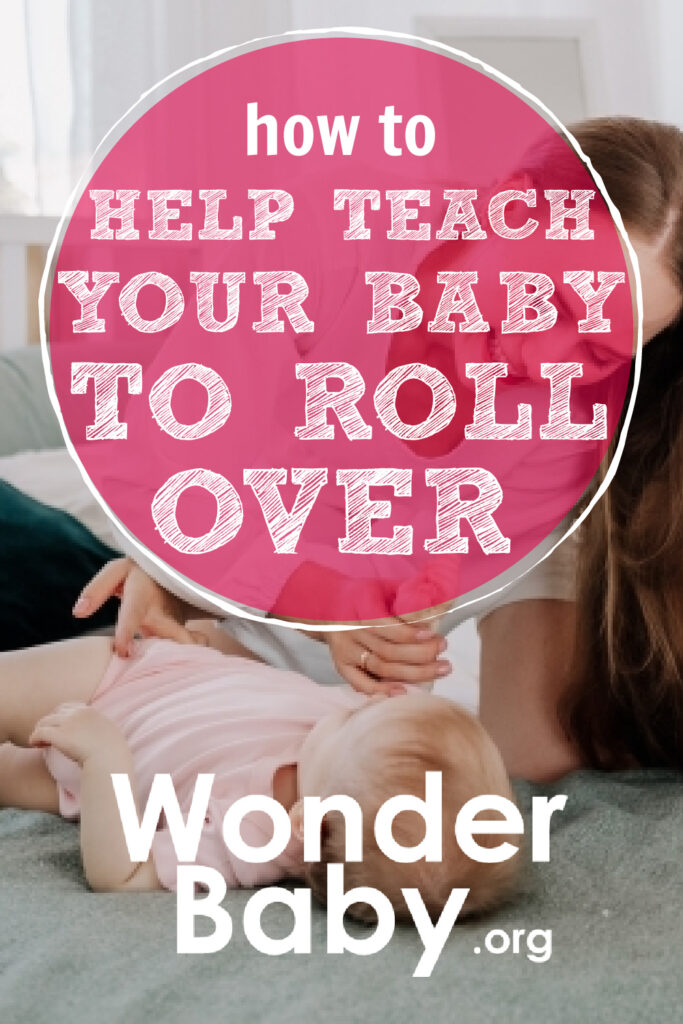How to Help Teach Your Baby to Roll Over

- Watching your baby learn to roll is an exciting milestone to welcome and enjoy.
- You can help your baby achieve this new skill by encouraging them in simple ways and supporting them during tummy time.
- All babies reach their milestones at different times, but it’s important to see your doctor if you think your baby isn’t developing skills like rolling by around six months.
I remember when my son rolled over on the floor for the first time. We were delighted and so impressed by this baby achievement, especially after watching him try so hard to figure it out for so many weeks. There was some frustration and crying along the way, but once he got the hang of it, it wasn’t long before he was sitting up and crawling too.
It is remarkable to watch a baby realize that they can control their own body when they learn to roll. You can help teach your baby to roll over by engaging with them during tummy time and encouraging them in simple ways to get used to different positions.
Is Your Baby Getting Ready to Roll Over?
Most babies start rolling over between four and six months, although some may start earlier or later. The skills involved in rolling over are also skills they will need in the first stages of crawling. Most babies start to roll from belly to back first, but some do the opposite, which is perfectly fine.
As with any developmental milestone, every baby will come to roll in their own time and in their own way. However, you can expect that most babies will be at least practicing the skills involved in rolling by around six months.
According to the experts, there are some telltale signs that your baby is getting ready to roll:
| Around 4 months | Your baby can lift their head and may try to push up on their arms, lift their chest and arch their back when they are on their tummy |
| Around 5 months | Your baby may start kicking their legs and moving their arms as if they’re “swimming” when they’re on their stomach |
| Around 6 months | Your baby may start to roll in one direction consistently, usually tummy to back at first |
Children with special needs may reach these milestones later. It may be helpful for parents to consult development charts for children who may have slower physical development to put them at ease and to help them celebrate their baby’s achievements.

Effective Ways to Encourage Your Baby to Roll Over
You may not be sure exactly how to help your baby roll over when it’s time. How much tummy time should they have? What if it seems they don’t like it or don’t want to roll over? What do you encourage first – back to belly or belly to back?
As with so many things with children, play, touch, and communication are the best ways to motivate your baby to roll. Here are a few tips to help you teach your baby to roll:
Tummy Time
Tummy time is placing a baby on their tummy while they’re awake and under close supervision. It gives them time to play, develop their neck muscles, and experience different body movements and positions in preparation to roll, crawl, and sit up.
Experts recommend that newborns from one to three months of age spend three to five minutes on their tummies, two to three times a day. Tummy time is important to help develop your baby’s muscles in their neck, shoulders and back. It also helps prevent your baby from developing flat spots on their head, known as positional plagiocephaly.
However, some babies may find tummy time tiring or frustrating. They may cry or become fussy in this new position. It’s a good idea to start tummy time when your baby has slept, has been changed, has eaten, is alert and ready to play.
Get down on the floor with your baby and make eye contact. Communicate, sing, interact and have fun during tummy time to encourage them. Some strategic toy placement on the floor where your baby can see toys that interest them will motivate them to reach, move their head, and start to roll.
Help Your Baby Get Into Position
You can introduce the feeling of rolling to your baby. For example, when you go to pick up your baby, roll them on their side first and then raise them up. You can also place your baby laying on their side to play, with your support if necessary, so that they can try it out.
Letting your baby play on their side and back is just as important as tummy time. Eventually, they will get themselves into each of these body positions, so showing them what it feels like sets the stage for them to roll over independently.
Give Your Baby Time Outside the Bouncer
Bouncers, swings, and other baby equipment are great for entertaining babies and helping them move for short periods. It’s important, however, not to overuse these toys and to give your baby time to play and to learn to move their body and head freely.

Maintaining Safety While Your Baby Is Rolling Over
Once your baby starts rolling, it’s important to ensure they are in a safe and appropriate space when practicing their new skill. Rolling means they are now mobile. With mobility, however, comes more opportunity for accidents, so here are some tips to keep in mind once your baby is on the move:
Never Leave Your Baby Unattended
Once your baby is rolling, their ability to move can escalate quickly. They may start moving in ways you don’t expect, which can also land them in a difficult position. Always make sure your baby is awake during tummy time. Be sure to supervise them closely.
Create a Safe Space
Make sure your baby is on a flat, firm surface free of pillows and soft toys that they may roll into but may not be able to roll out of, posing a suffocation risk. Do not place babies on elevated surfaces like a bed, sofa, or changing table when on their belly or for tummy time because they can roll off.
You can set up a fun and safe space for your baby on the floor. A firm crawling mat is preferable to a blanket with corners that can flip up and cover them. Keep interesting crawling toys within reach, like balls and tactile activity books, to motivate your baby to roll, reach with their arms, lift their chest, and use their upper body.
Keep this space free of furniture, dangling threads, and loose or fluffy objects. Make sure you baby-proof any electrical sockets nearby. Look for potential hazards like sharp corners or edges. You want to make sure there is nothing within reach that your baby could get tangled up in or cause them to choke.
Sleep Safety
Even once your baby reaches the developmental milestone of rolling, the safest position for sleep is still on their back until they’re a year old. The American Academy of Pediatrics recommends back sleeping until this age to reduce the risk of sudden infant death syndrome (SIDS).
You may find some babies sleep facing down even when they start the night sleeping on their backs. Your baby may have learned to roll from tummy to back, but it can take them some time to learn to roll the opposite way. That’s why it’s important that you still place them to sleep in a safe position on their back to reduce the risk of suffocation.
Avoid using toys or blankets to keep them in the desired back-sleeping position, however, since those can pose a suffocation risk. Follow the ABCs of safe sleeping: Alone, Back, Crib.
If your baby rolls over in their sleep, experts recommend that you reposition them on their backs, even if your baby’s head is turned to the side. You should do this until you know that your baby can consistently roll back to belly and belly to back on their own.
When Should You Be Worried if Your Baby Isn’t Rolling Over?
You’ve been trying to encourage your baby to roll, but they just don’t seem to want to reach for those toys you’ve laid out. Or your baby finds tummy time really distressing no matter how little time they spend on their belly or how you support them. Should you be concerned about your baby’s development? Are these signs of gross motor delay?
Although rolling is a developmental milestone, not every baby will reach it at the same age or master it in the same amount of time. Some babies may start rolling early at four months. Others may not have rolling down until they’re six months old. How can you tell if your baby is making progress?
Here are some signs to look out for from the American Academy of Pediatrics that will help you decide when it’s time to call your doctor:
- Your baby was able to roll, but now they can’t. You should call your doctor right away because this may be a sign of a health problem.
- Your baby is six months old and can’t roll in both directions. Talk to your doctor. It may not be cause for concern, but having your pediatrician check it out is a good idea.
- Your baby is six months old, but their muscles are tight and stiff or floppy when they try to roll. Again, it’s important to talk to your doctor to ensure your baby is developing as expected.
FAQs
Can babies roll over too early?
Sometimes babies can do things you don’t expect. Generally, babies may start rolling or pre-rolling movements between two and four months and start rolling in earnest between four and six months.
If a baby rolls before two months of age with tight or stiff muscles, it could be an early sign of cerebral palsy. It’s a good idea to talk to your doctor if you’re concerned about your young baby’s movement.

The information WonderBaby provides is not intended to be, and does not constitute, medical or other health advice or diagnosis and should not be used as such. Always consult with a qualified medical professional about your specific circumstances.
Related Posts

Development, Special Needs
How to Track Milestones for Developmentally Delayed Babies
Parents of developmentally delayed babies can explore practical tools and strategies to track milestones, celebrate progress, and support their child’s unique developmental journey.

Fine and Gross Motor
5 Alternatives to Tummy Time for Babies with Motor Development Challenges
Does your baby struggle with tummy time due to motor development challenges? These alternatives to tummy time will offer the same benefits.

Development
Should Twins Share a Room?
Wondering if your twins should share a room? We’ll explore the pros and cons of room-sharing for twins right here before you make your decision.